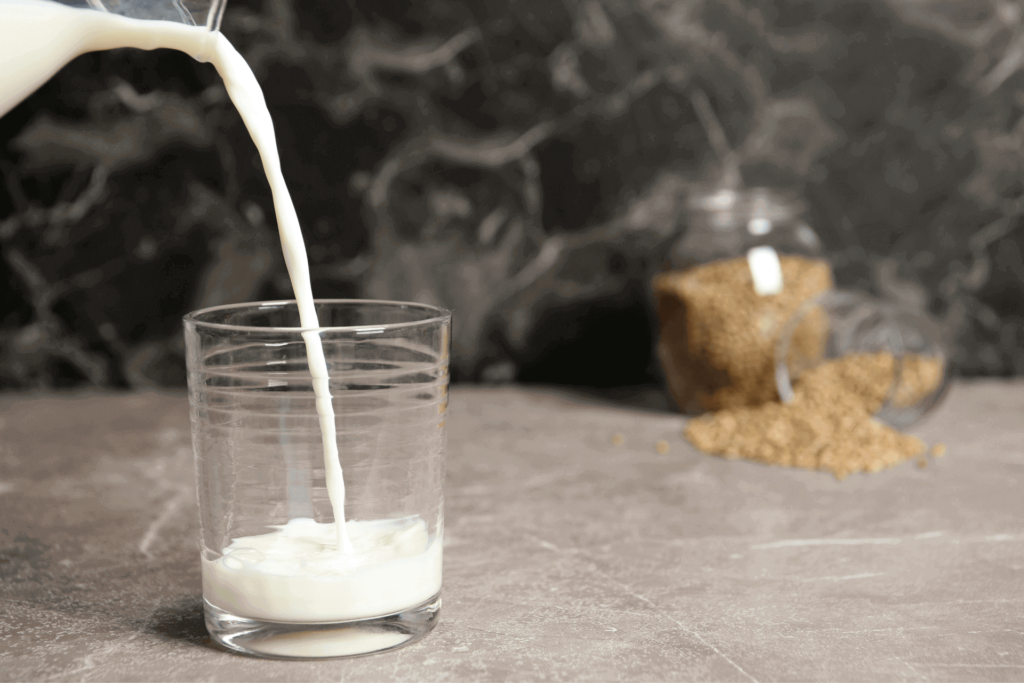This post may contain affiliate links. Please read my disclosure for more info.
Ready to upgrade from basic drip coffee to the exciting world of lattes, cappuccinos, and macchiatos? To enjoy these cool coffee shop favorites at home, you’ll need to master the art of milk frothing.
In this post, we’re diving into the perfect milk choices for creating that creamy froth, especially for those on a diet, lactose intolerant, or following a vegan lifestyle. Plus, we’ll share essential frothing tips and guide you on choosing the right milk frother for your coffee adventures.
Quick Take: Best Milk for Frothing
| Image | Product | ||
|---|---|---|---|
|
Best milk for frothing |

|
Whole milk | Check price |
|
Easiest frothing milk |

|
Skim milk | Check price |
|
Best non-dairy milk for frothing |

|
Oat milk | Check price |

|
Almond milk | Check price | |

|
Soy milk | Check price |
What Makes a Good Frothing Milk?
Let’s break down milk like a simple science lesson. Think of milk as a mix of fats, proteins, and sugars. The balance of fat and protein in it determines how well it foams up.
Full-fat milk creates a rich, creamy foam that tastes amazing. However, its heaviness means it doesn’t last as long as lighter foams.
Using milk that’s low in fat and high in protein gives you fluffy, light foam. It might not taste as rich as foam from full-fat milk, but it stays frothy for a longer time.

Milk contains two key proteins: caseins and whey. When you heat it, whey protein adds a unique taste to your coffee. This little detail can transform your coffee experience!
Caseins play a big role in how milk feels. In milk, caseins group up into tiny balls known as micelles. When milk is steamed, these micelles break apart, and casein molecules wrap around air bubbles. This process traps air, creating the bubbles we see in milk foam.
Can You Froth Non-Dairy Milks?
Milk for frothing doesn’t have to come from cows. Different milks have unique mixes of proteins, sugars, and fats. Some are too thin and barely froth. But, others are creamy like cow’s milk and whip up into gorgeous foam. Whether dairy or plant-based, the right milk can make your coffee extra special.
Exploring each milk type is key. Sometimes, the brand matters too, especially with non-dairy options. They’re packed with extras like proteins and fats, affecting the outcome. Let’s dive into how these ingredients can change your coffee experience.
General Tips for Frothing Milk
Before diving into our list, remember these key tips for perfect milk frothing.
Picking a Milk Frother and Steamer
Explore different frothers and steamers for your perfect coffee foam.
- Handheld milk frothers — like the Zulay Original — are great starter options due to their low price point and easy operation. They don’t typically come with containers for the milk, though, and they don’t heat the milk. You’ll need to microwave or otherwise bring the milk up to temperature before using them.
- Manual milk frothers — like the Ninja Easy Frother — operate with a plunger very similar to that of a French press. Many of these frothers are made of microwaveable glass or plastic, so you can heat the milk without transferring it. The actual frothing takes a bit more effort, but these can be a cheap and very convenient option if you don’t mind a bit of plunging.
- Electric milk frothers — like the Nespresso Aeroccino3 — tend to be more expensive than the previous two options. For that extra price, though, you get a machine that heats the milk while frothing it, so the entire process is completed often with a single button press. The temperatures are typically more accurate than what you’ll get by microwaving milk, and models like the Brevillle BMF600XL even offer customizable temperatures for use with non-dairy milk.
- Steam wands — Most espresso machines have built-in steam wands, allowing you to heat and froth milk without the need for extra equipment. These have a higher learning curve than the other options, but they offer maximal flexibility for how you froth your milk. If you don’t have an espresso machine, though, you likely need to go with one of the above options instead.
Milk frothing temperature
The perfect temperature to froth cow’s milk is between 150–155 degrees Fahrenheit. If your coffee is for later, you can heat it up to 160 degrees. But remember, never go over 170 degrees, because that’s when the milk proteins begin to spoil.
When swapping cow’s milk for a plant-based option, remember different milks need different temperatures. Plant milks often can’t handle heat as well. For example, soy milk starts to break down and taste sour if it gets hotter than 140 degrees. So, to avoid a curdled mess, keep an eye on the temperature!
Pre-heat your mug
To make your coffee taste perfect, it’s crucial to keep your cup warm. Pre-heating your mug helps a lot. Luckily, many affordable espresso machines come with cup warmers, making it super easy!
No cup warmer? No problem! Just pour almost-boiling water into your mug and wait a few minutes. Then, dump out the water and replace it with your coffee. Simple and effective!
Keep the milk fresh and cold
For the creamiest foam, use milk within the first five days of buying it. While you can froth milk that’s still good to drink later on, it’s those early days that give you the best froth.
To keep your milk fresh longer, store it in a dark container away from light. Clear milk bottles aren’t the best choice—they can cause your milk to spoil faster.
Always start frothing with milk fresh from the fridge – it should be super cold!
Safety First
Always clean your coffee gear after use. Leftover milk can spoil the taste and even make your drink unsafe. Keep it fresh and safe every time.
Mixing fresh milk with steamed milk can lead to bacteria. Stick to one: use either steamed or fresh milk, but not both.
The Best Milk for Frothing
Best milk for frothing: Whole milk
Whole milk takes the crown when it comes to frothing. Its magic lies in a perfect mix: rich in fat (3.5%) and just enough protein (3.2%). This combo whips up a creamy, dreamy foam that’s hard to beat. It’s our gold standard in this frothy journey we’re exploring today.
Choosing the right whole milk for your coffee matters. Different brands come from different cows, diets, and freshness levels, all affecting your cup’s taste.
Whole milk foam tastes amazing but doesn’t last long. It breaks down quicker than foam from lower-fat milks. For the best experience, serve it right after you make it!
Not a fan of whole milk foam? Whether you’re lactose-intolerant, watching your calories, or just not into the taste, I’ve got lots of other choices for you below.
Easiest frothing milk: Skim milk
Frothing milk can be simple! While whole milk takes a bit of practice, skim milk is perfect for beginners. It creates big bubbles almost effortlessly, and its foam lasts much longer than whole milk’s.
Skim milk won’t give you that creamy froth like whole milk does. For a silky, luxurious latte, stick with whole milk. But, if you prefer drinks with less milk, such as espresso macchiatos or cappuccinos, skim milk might be your best pick.
Best non-dairy milk for frothing: Oat milk
If you’re exploring dairy-free options but still crave that creamy froth in your coffee, oat milk is your go-to. Unlike other vegan milks that can be too thin, oat milk is rich and creamy, creating a foam that’s delightfully close to what you get with whole milk, even though it has less protein and fat.
One downside of oat milk, like many plant-based milks, is its foam doesn’t last. Despite not being too watery, oat milk has a lot of water. This means the lovely foam on your coffee won’t stay fluffy for long, disappearing quicker than the foam from whole milk.
Almond milk
Almond milk keeps its sweet taste even when it’s foamed, making it great for drinks without extra sugar. Plus, you can foam it at a cooler 130 degrees Fahrenheit, lower than what cow’s milk needs. This makes it a friendly option for your coffee.
Did you know not all almond milk is the same for making that perfect frothy coffee? I’ve discovered Califia Farms Barista Blend tops the list! Whether you prefer sweetened or unsweetened, it gives your coffee a creamy, rich froth that’s just delightful.
Soy milk
Soy milk whips up into a creamy, thick foam just like cow’s milk, becoming a top non-dairy choice for frothy coffee drinks in cafes.
Soy milk has its challenges when frothing. First off, it’s too fluffy for making those cool latte art designs because it doesn’t pour smoothly. Also, watch the heat! Keep it under 150 degrees Fahrenheit to prevent it from curdling. Lastly, stick to less acidic coffee. Why? The foam from soy milk doesn’t hold up well in a very acidic environment.
For creamy froth, try Soy Dream! It’s rich in protein, froths beautifully, and is USDA Organic. Perfect for coffee lovers starting with soy milk.
Worst Milk for Frothing
Coconut milk
Attention coconut milk lovers, I might ruffle some feathers here. While a few coconut milk brands work well for frothing, sadly, most just don’t make the cut.
Nut milk often makes your coffee thin and watery. Plus, coconut milk adds a strong, unique taste that might overpower your coffee’s flavor. If you enjoy that, great! But if you’re after the coffee’s true taste, it might be too much.
When choosing coconut milk for your coffee, skip the low-fat or canned options. Go for whole fat coconut milk from cartons – it’s your best bet for creating that creamy, thick froth you’re after.
Cashew milk
Cashew milk? It’s a no-go for frothing. Even more watery than coconut milk, it barely makes a foam. And the little foam it does make? It disappears too fast to even enjoy. Stick to other options!
Macadamia milk
Macadamia milk struggles to foam up. While Milkadamia performs a bit better, it still can’t whip up much lasting froth.
Rice milk
Many people enjoy rice milk for its low fat, but this makes it a poor choice for frothing. Trying to froth it? You’ll end up with just a few bubbles, if any at all.
Hemp milk

Just like others in its group, hemp milk is too watery to create good froth. Even worse, if it’s not heated right before mixing with your coffee, it curdles. Believe me, it’s a taste you’d rather avoid.
Final Verdict
To make amazing espresso drinks at home, you’ll need to master milk frothing. The first step? Choosing the right milk. While whole milk is a classic choice, it’s important to know there are lots of options out there for vegans and those watching their diet. Let’s dive into finding the perfect milk for your home café creations.
Kickstart your coffee journey with creamy milk and tasty espresso beans. Next, pick your perfect coffee maker. Don’t forget a quality grinder for the freshest brew—unless you opt for a convenient Nespresso, Keurig, or another pod machine.
Take it slow, step by step. For now, treat yourself to a well-deserved break with a delicious homemade cappuccino.






